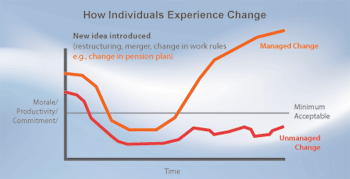Successfully leading a large organization through a time of change or uncertainty is not solely about developing and executing a business plan. Success during periods of dislocation often hinges on ensuring that employees at all levels understand the rationale for business decisions and their employer’s overall strategic direction. This is especially true during a period of se¬vere economic distress, when management may be forced to radically shift its priorities over a relatively short timeframe. Budgets are re-adjusted, positions are eliminated, expansion plans are indefinitely postponed, and cost-containment measures are implemented.
 Needless to say, employees care about the impact the economy will have on their company and their personal welfare. Yet many firms neglect to engage their workforce in meaningful discussions about this. The result is a poorly managed change process that saps morale and decreases productivity.
Needless to say, employees care about the impact the economy will have on their company and their personal welfare. Yet many firms neglect to engage their workforce in meaningful discussions about this. The result is a poorly managed change process that saps morale and decreases productivity.
Individuals experience change in different ways. But there are some commonalities to the expe¬rience. Figure one (see above) highlights the three phases of how individuals deal with change; in a work context, these changes can include layoffs, a reduction in work hours and other de¬stabilizing events. In these instances, most people experience concern, fear, uncertainty and, sometimes, anger and denial. When this occurs, a phase of “undirected energy” sets in, in which employees still report for work but are often disconnected from the tasks at hand. If not managed properly, this process can demoralize a workforce.
However, when an organization takes a systematic approach to organizational change and engages its workforce in discussions about how current realities are impacting strategy, the or¬ganization can quickly navigate through the trough represented in Figure two (see below) more rapidly than if communications are ad hoc or unfocused.
Context: Communicating the “Why?”
During the current economic downturn, employees are understandably uneasy. They are in¬undated with information from a variety of sources about problems at myriad other  firms and worry that their company will be similarly affected. Moreover, they are witnessing firsthand the struggles and financial hardships among their families and friends. Accordingly, they want their employers to be as candid as possible about what may lie ahead. Yet, management does not always have the ability to provide guidance far into the future. Employees are hoping for the larger context behind their firm’s decisions. Explaining the “why” is a critical tenet of effective communications and can be the difference between making an employee feel like a meaningful contributor or just a small cog in the organization.
firms and worry that their company will be similarly affected. Moreover, they are witnessing firsthand the struggles and financial hardships among their families and friends. Accordingly, they want their employers to be as candid as possible about what may lie ahead. Yet, management does not always have the ability to provide guidance far into the future. Employees are hoping for the larger context behind their firm’s decisions. Explaining the “why” is a critical tenet of effective communications and can be the difference between making an employee feel like a meaningful contributor or just a small cog in the organization.
Employees:
- Want to know the “why” of change
- Want to know what lies ahead
- Want all of the facts to help in their own decisions
- Expect transparency and honesty – even if the company doesn’t have all the answers
Engaging in the Front Lines
While it is important that CEOs and other senior executives remain visible to employees during tumultuous times, it is also critical to empower middle management with the tools to have can¬did and meaningful discussions with the rank-and-file workforce. Many employees trust their direct supervisor more than any other source of information about their career and their com¬pany. Accordingly, “front-line” managers need to be equipped with the communications skills for meaningful interactions with staff. Yet, most managers do not realize that maintaining lines of communication with their direct reports is part of their everyday responsibilities. Indeed, for most managers, change management communications is a skill that needs to be taught.
Senior leadership is responsible for ensuring that accurate messages are promptly and con¬tinually delivered to front-line managers through established systems and channels, and that managers receive proper training on how to convey messages in an appropriate manner. This includes how to field difficult questions or respond to rumors at a staff meeting as well as during a one-on-one encounter.
Managers may be confronted by a vocal or skeptical employee, and therefore need to be pre¬pared for such an interaction ahead of time. Otherwise, they may suddenly find themselves in a defensive crouch, which can lead to an ineffective and potentially damaging exchange with staff. To defuse tense situations, managers need to be taught to listen to an employee’s inquiries with courtesy and respect, as well as avoid deep, prolonged conversations about hypothetical situations. Importantly, managers need to be trained to anticipate the possible questions they may receive.
Clear Messages to Weather The Storm
Strong organizational communications becomes a critical asset to achieve a firm’s long-term strategic goals during a period of uncertainty. Burson-Marsteller has found that a robust in¬ternal communications program achieves high levels (60 percent to 80 percent) of employee awareness about a shift in strategy or direction. Conversely, a poorly managed program can lead to organizational confusion. Internal messages should be clear enough that they empower managers to have candid discussions. Messages should clearly communicate the company’s direction, strategy and critical challenges, as well as bridge day-to-day concerns and issues on the minds of employees.
Benefits of Managed Organizational Change:
- More consistent communication about business direction
- Managers are more confident engaging employees about the business
- Employees understand how what they do every day impacts the success of the organization
This white paper was written by the Burson-Marsteller Organizational Performance Group.
